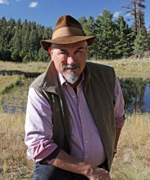 —Alan Dulaney
—Alan Dulaney
Regardless of whatever happens with COVID-19, other things keep happening too. In April government-related things happened on the Federal level, the state level, and locally.
On the Federal level, the new rule defining “Water of the United States” was issued in final form on April 21. The definition of WOTUS for Arizona is somewhat tighter, which the Department of Environmental Quality supports. Groundwater, storm water runoff, ditches, and artificial lakes and ponds are excluded. More importantly, ephemeral streams are not included in the definition. While the new rule is due to go into effect on June 22 across the nation, litigation awaits. The State of Colorado and various NGOs, such as the Center of Biological Diversity, and the Natural Resources Defense Council, have all indicated their intention to take legal action to stay implementation of the new rule. It appears that ADEQ will not regulate Waters of the State (WOTS) under the Clean Water Act NPDES program but will continue to regulate any point source discharge to WOTUS under CWA Section 402. ADEQ will regulate WOTS, which is pretty much all surface and groundwater resources within or adjacent to Arizona. ADEQ has formed a stakeholders’ group to look at how WOTS might be regulated.
At the state level—in addition to the still fluid ADEQ approach to WOTUS and WOTS—portions of the Drought Contingency Plan appear to be unraveling. Among the many moving parts of the DCP machine was the expectation of Federal grant money to Pinal County irrigation districts, primarily to drill or modify groundwater wells. Some $10 million was envisioned to flow through the Natural Resources Conservation Service, which in turn would back up a $20 million loan promised from the state. However, the $10 million would be awarded only if NRCS saw sufficient conservation measures from Pinal County irrigation districts. State and Federal officials are still negotiating over the grant, with input from the irrigation districts. You can read a lengthy description of the standoff here. Given the current economic conditions, money for new wells might help save some of Arizona’s drilling firms.
At the local level, two researchers from Arizona State University have come up with a technique that would aid epidemiological studies of COVID-19 through wastewater analysis. High sensitivity analyses of wastewater influent samples can detect nucleic acid fragments of the SARS-CoV-2 virus. These remnants mark the presence of the virus, and are accurate in tracking its spread. Samples can be affected by seasonal temperatures, influent transit time, demographics, and per-person water usage, so calibration is critical. Infected individuals cannot be identified, but this technique could prove a cost-effective and accurate tool for measuring and modeling the presence of the virus in populations served by a sewer system. Most large cities and towns where the disease is likely to spread are served by sewage systems that already take influent samples for various purposes. Wastewater plants can produce more than reclaimed water for recharge or direct use; influent sampling can become a major epidemiological tool.